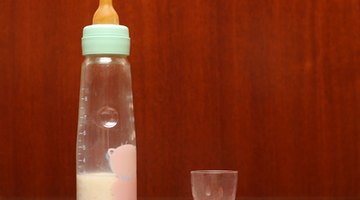Breast-Feeding Guidelines: How Many Ounces to Feed Your Baby?
Breast-feeding moms often worry about whether their babies are receiving the right amount of milk. If a mom exclusively nurses, she has no way to measure exactly how much breast milk her baby consumes at each feeding.
If a mom pumps, she may notice that her baby's formula-fed peers consume significantly more milk than her baby does, according to the book "Breastfeeding Made Simple." By understanding the normal milk consumption guidelines for breast-fed babies, breast-feeding moms can feel more confident in their ability to tell if their baby is receiving enough milk.
First Month
During the first month of life, the amount of breast milk a newborn needs increases rapidly. On his first day of a life, a newborn's stomach is about the size of a marble and has very little ability to stretch. He can only consume about 1 oz. of colostrum, which is the early, antibiotic-rich form of breast milk. By day five, his expanding stomach -- now the size of a golf ball -- can take in 10 oz. to 12 oz. daily. In the second and third weeks, he takes in about 20 oz. to 25 oz.
each day, and in the fourth week, his daily consumption reaches approximately 25 oz. to 30 oz., explain the authors of "Breastfeeding Made Simple."
1 to 6 Months

How Much Should Babies Be Eating at 10 Weeks?
Learn More
By 1 month old, a baby's daily milk consumption varies from 19 oz. to 30 oz. each day, with an average of about 25 oz.
This daily intake of breast milk remains the same from 1 month until around 6 months old.
A baby's age and weight don't affect the amount of breast milk she consumes each day. However, during growth spurts -- periods during which a baby temporarily increases her milk intake -- she may consume more milk than normal for about two to three days. For many babies, growth spurts occur around 3 months, 4 months and 6 months old.
After 6 Months
Around 6 months old, as a baby starts eating solid foods, the amount of milk he consumes gradually decreases. How much it decreases varies, based on the amount of solids he is eating. The more solids he consumes, the less breast milk he will need.
While breast milk should still provide most of his nutrition, a baby's milk intake may drop from 30 oz. at 7 months to 19 oz. by 11 or 12 months, according to international board-certified lactation consultant Kelly Bonyata.
Signs of Adequate Milk Intake

How Much and How Often Should a Four-Month-Old Eat?
Learn More
Breast-feeding moms can look for a number of signs to tell if their baby is meeting the guidelines for adequate milk consumption.
During the first six weeks of life, an adequately fed breast-fed baby should produce at least three to four quarter-sized stools each day.
After the first six weeks, she should produce at least four to five sopping wet, disposable diapers, or five to six cloth diapers, daily.
Breast-fed babies average a weight gain of 6 oz. a week during the first four months, 4 to 5 oz. a week between 4 and 6 months old, and 2 to 4 oz.
a week between 6 and 12 months old. The baby should also seem satisfied after nursing, be active and alert and meet her developmental milestones.











